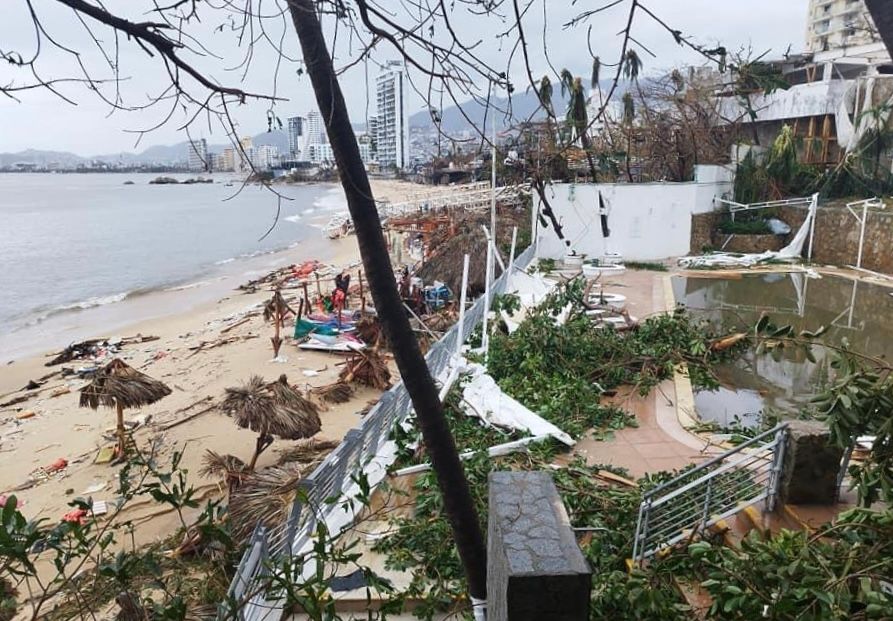Manipulating Hurricanes and Typhoons: A Comprehensive Analysis
1.1 Background Tropical cyclones, also known as hurricanes or typhoons depending on their location, represent some of the most potent forces in nature, characterized by strong winds, heavy rainfall, and storm surges. These severe weather events form over warm ocean waters, drawing energy from the heat released by condensation

1.1 Background
Tropical cyclones, also known as hurricanes or typhoons depending on their location, represent some of the most potent forces in nature, characterized by strong winds, heavy rainfall, and storm surges. These severe weather events form over warm ocean waters, drawing energy from the heat released by condensation processes in towering thunderstorms near their cores.
The devastating impact of tropical cyclones on human societies is profound and multifaceted. Communities in the path of these storms can experience severe wind damage, widespread flooding, and loss of life. The economic toll is also significant, encompassing the immediate costs of disaster response and recovery, as well as the longer-term impacts on infrastructure, agriculture, and local economies.
In recent decades, there has been a notable trend of increasing frequency and intensity of tropical cyclones, a phenomenon that has been partly attributed to the effects of climate change. As the planet warms, sea surface temperatures rise, providing more energy and favorable conditions for the formation of these storms. The Intergovernmental Panel on Climate Change (IPCC) has highlighted the likelihood of more intense and wetter tropical cyclones as a consequence of global warming.
This changing landscape of risk has ignited interest and investment in developing strategies and technologies to mitigate the impacts of tropical cyclones. These efforts range from improved forecasting and early warning systems, to more speculative and controversial approaches such as weather modification and geoengineering. The latter category includes a variety of proposed techniques to either prevent the formation of these storms, weaken them before they make landfall, or alter their paths away from populated areas.
The challenge, however, is immense. Tropical cyclones are complex and chaotic systems, influenced by a myriad of factors at both local and global scales. Successfully intervening in these processes without causing unintended consequences requires a deep understanding of atmospheric science, as well as advanced technological capabilities.
The pursuit of such capabilities raises important ethical questions about humanity’s relationship with nature and the potential risks and benefits of intervening in natural processes. As we continue to explore the boundaries of what is possible in mitigating the impacts of tropical cyclones, it is crucial that we approach these challenges with caution, transparency, and a commitment to equitable and sustainable solutions.
Scientific Principles of Tropical Cyclones
2.1 Formation and Development
Tropical cyclones, awe-inspiring in their power, are complex atmospheric phenomena fueled by the interplay of various meteorological and oceanographic processes. Central to their formation and development is the availability of warm ocean waters, which serve as the primary source of energy and moisture for these storms.
To initiate the formation of a tropical cyclone, sea surface temperatures typically need to be at least 26.5 degrees Celsius (80 degrees Fahrenheit) or warmer, extending to a depth of about 50 meters (164 feet). This warm water heats the air above, causing it to rise and create an area of low pressure beneath. As the air ascends, it cools and the water vapor condenses, releasing latent heat. This release of heat further warms the surrounding air, causing it to rise as well and creating a self-sustaining cycle.
The Earth’s rotation plays a crucial role in the development of tropical cyclones through the Coriolis effect, which causes the storm system to spin. In the Northern Hemisphere, tropical cyclones rotate counterclockwise, while in the Southern Hemisphere, they rotate clockwise. This spin is vital for the organization of the storm and contributes to the development of its characteristic eye and eyewall structure.
The formation of a tropical cyclone also requires a pre-existing weather disturbance, such as a cluster of thunderstorms, to provide an initial trigger for the upward motion of air. Additionally, the atmosphere must have a certain degree of humidity and vertical wind shear (the change in wind speed and direction with height) must be low. High wind shear can tilt the vortex of the cyclone and disrupt the flow of heat and moisture, hindering the storm's development or causing it to dissipate.
As the storm system gathers strength and organization, it progresses through various stages of intensity, classified as tropical depressions, tropical storms, and finally, hurricanes or typhoons. The Saffir-Simpson Hurricane Wind Scale is commonly used to categorize the intensity of these storms based on their sustained wind speeds, providing a measure of the potential damage and flooding they can cause.
Understanding the scientific principles underlying the formation and development of tropical cyclones is critical for predicting their occurrence, tracking their paths, and implementing effective mitigation strategies. As we delve deeper into the nuances of these processes, we pave the way for advancements in weather forecasting and disaster preparedness, ultimately contributing to the safeguarding of vulnerable communities and ecosystems.
2.2 Monitoring and Forecasting
The accurate monitoring and forecasting of tropical cyclones are crucial for timely disaster preparedness and risk mitigation. Over the years, significant strides have been made in these domains, largely attributed to advancements in satellite technology, radar systems, and computer modeling.
Satellites play a pivotal role in monitoring tropical cyclones, providing continuous, real-time data on storm development, movement, and intensity. Equipped with a variety of sensors, including visible and infrared cameras, microwave radiometers, and scatterometers, weather satellites capture detailed imagery and measurements that are instrumental in tracking cyclones. Geostationary satellites, positioned at a fixed point above the Earth, offer a constant eye on the storm, while polar-orbiting satellites provide a global perspective, capturing high-resolution data as they circle the planet.
Radar systems, particularly Doppler radar, have become indispensable tools in the monitoring of tropical cyclones. Installed on the ground and aboard aircraft, these radar systems emit radio waves that bounce back after hitting precipitation particles within the storm. Analyzing the returned signals enables meteorologists to construct detailed images of the storm's structure, providing insights into its intensity, rainfall distribution, and potential for severe weather such as tornadoes.
The advent of hurricane hunter aircraft has also played a significant role in enhancing our understanding of tropical cyclones. These specially equipped aircraft fly directly into storms, collecting invaluable data on wind speeds, pressure, temperature, and humidity. This information not only aids in real-time monitoring but also serves as critical input for numerical weather prediction models.
Computer modeling has emerged as a cornerstone of tropical cyclone forecasting, leveraging the wealth of data collected via satellites, radar, and aircraft to simulate the atmosphere and predict storm behavior. These models, running on powerful supercomputers, use complex mathematical equations to replicate the physical processes governing the atmosphere and oceans. By inputting current weather conditions and simulating their evolution over time, models provide forecasts of a storm's potential track, intensity, and impacts.
Despite these technological advancements, forecasting tropical cyclones remains a challenging task, fraught with uncertainties. The chaotic nature of the atmosphere, coupled with limitations in our understanding of some of the finer details of storm dynamics, can lead to forecast errors. However, continuous improvements in observational tools, data assimilation techniques, and model resolution are steadily enhancing forecast accuracy, providing communities with more lead time to prepare for the impacts of these formidable storms.
In conclusion, the synergistic use of satellite technology, radar systems, and computer modeling has revolutionized the monitoring and forecasting of tropical cyclones. These tools have not only deepened our scientific understanding of these phenomena but also played a crucial role in saving lives and mitigating damage through improved disaster preparedness and response.
Proposed Manipulation Strategies
3.1 Sea Surface Temperature Modification
The immense energy that fuels tropical cyclones is drawn from warm ocean waters. Disrupting this energy supply could, in theory, mitigate the intensity of these storms or potentially prevent their formation altogether. One innovative strategy proposed to achieve this involves the modification of sea surface temperatures in the path of an impending tropical cyclone.
3.1.1 Reflective Materials to Reduce Solar Absorption
One of the methods under consideration is the deployment of reflective materials on the ocean surface to reduce solar absorption and thereby lower sea surface temperatures. These materials could take the form of biodegradable films or reflective particles, designed to increase the albedo (reflectivity) of the water, resulting in less solar energy being absorbed and a subsequent cooling of the surface layer.
Researchers are investigating the feasibility and potential impacts of this approach, with experiments and modeling studies aimed at understanding how effectively these materials can reduce sea surface temperatures, and what quantities would be required to achieve a meaningful impact on a tropical cyclone. There are, however, significant logistical and environmental challenges associated with deploying and maintaining such materials over large oceanic expanses.
3.1.2 Utilizing Deep Ocean Water
Another approach to sea surface temperature modification involves utilizing cold water from the deep ocean to cool the surface layer. This could potentially be achieved through the use of pumps or other mechanisms to facilitate the upwelling of deep, cooler water to the surface. In doing so, the temperature differential between the ocean surface and the atmosphere would decrease, potentially weakening the cyclone or inhibiting its formation.
This method, while conceptually promising, also presents considerable technical challenges. The scale of intervention required to affect a tropical cyclone is immense, and there are concerns about the potential ecological impacts of altering natural ocean stratification and nutrient distribution.
3.1.3 Assessing Risks and Unintended Consequences
While sea surface temperature modification presents a tantalizing avenue for tropical cyclone manipulation, it is imperative to thoroughly assess the potential risks and unintended consequences of such interventions. Altering the natural heat balance of the oceans could have far-reaching impacts on marine ecosystems, fisheries, and global climate patterns.
Furthermore, the ethical implications of manipulating such fundamental natural processes must be carefully considered. The potential for unequal impacts, where interventions benefit one region at the expense of another, raises questions of governance, accountability, and environmental justice.
In conclusion, sea surface temperature modification holds potential as a strategy for mitigating the impacts of tropical cyclones. However, the complexity of the associated technical, ecological, and ethical challenges necessitates a cautious and rigorous approach to research and development in this area. Only through a comprehensive understanding of the potential benefits and risks can we hope to responsibly harness the power of this innovative strategy.
Risks and Challenges
4.1 Unintended Consequences
The prospect of manipulating tropical cyclones, despite its potential benefits, is fraught with inherent risks, chiefly among them being the potential for unintended consequences. The complexity and interconnectedness of atmospheric systems mean that interventions aimed at altering one aspect of a cyclone’s behavior could inadvertently trigger cascading effects, leading to unpredictable and potentially detrimental changes.
4.1.1 Amplification of Storm Intensity
One of the primary concerns is that attempts to weaken a storm or alter its trajectory could backfire, inadvertently resulting in an amplification of the cyclone's intensity. The delicate balance of forces within a tropical cyclone is not fully understood, and even well-intentioned interventions could disrupt this balance, leading to unforeseen outcomes.
4.1.2 Impact on Precipitation Patterns
Manipulating a tropical cyclone could also lead to significant alterations in precipitation patterns. By attempting to steer a storm away from one area, it might be directed towards another, potentially resulting in excessive rainfall and flooding in regions unprepared for such an event. Additionally, interventions aimed at dissipating a storm could suppress precipitation to the extent that it leads to drought conditions, particularly in regions that depend on seasonal cyclones for their water supply.
4.1.3 Regional and Global Climatic Effects
The potential regional and global climatic effects of tropical cyclone manipulation are a subject of ongoing research and debate. There are concerns that large-scale interventions could disrupt established atmospheric circulation patterns, leading to shifts in weather and climate in distant regions. The long-term impacts of such changes are difficult to predict and could have profound implications for ecosystems, agriculture, and human populations.
4.1.4 Ethical and Governance Challenges
Beyond the physical risks, manipulating tropical cyclones raises complex ethical and governance challenges. Deciding when and how to intervene requires careful consideration of the potential winners and losers of such actions. The lack of clear international guidelines and regulations on weather modification adds another layer of complexity, raising questions about accountability and the potential for conflict over the use of these technologies.
In summary, while the manipulation of tropical cyclones presents a tantalizing opportunity to mitigate the impacts of these devastating storms, it is imperative to approach this field with caution. A thorough understanding of the potential unintended consequences, coupled with robust ethical and governance frameworks, is crucial to ensuring that any interventions are conducted responsibly and equitably. The stakes are high, and the responsibility to tread carefully and thoughtfully in this uncharted territory cannot be overstated.
Ethical and Social Considerations
5.1 Responsibility and Accountability
The active intervention in natural weather phenomena, such as manipulating tropical cyclones, ventures into a realm fraught with ethical complexities and necessitates a careful consideration of responsibility and accountability. It prompts us to question not just our ability to enact such interventions, but also the moral implications and potential societal ramifications.
5.1.1 Informed Consent and Public Participation
One of the cornerstones of ethical practice in any field is the principle of informed consent, ensuring that those affected by an intervention have a voice in the decision-making process. In the context of tropical cyclone manipulation, this principle poses significant challenges. The vast and indiscriminate nature of weather patterns means that interventions can have far-reaching impacts, affecting populations across borders and continents. Establishing a framework for meaningful public participation and informed consent under these circumstances is a daunting task, yet it is a crucial component of responsible practice.
5.1.2 Equity and Justice
The potential benefits and risks of tropical cyclone manipulation are unlikely to be distributed evenly. Some regions may experience reduced storm impacts, while others could face unintended adverse effects. This raises critical questions of equity and justice, particularly if the communities bearing the brunt of negative consequences are those with the least resources and power. Ensuring that interventions do not exacerbate existing inequalities, and that vulnerable populations are protected, is a paramount concern.
5.1.3 Potential for Misuse
The ability to influence weather patterns opens up the possibility of misuse, whether for geopolitical advantage, economic gain, or military purposes. The dual-use nature of tropical cyclone manipulation technologies necessitates strict oversight and regulation to prevent exploitation and to ensure that these capabilities are used solely for humanitarian and protective purposes.
5.1.4 Long-term Implications and Stewardship
Engaging in weather manipulation carries with it a responsibility for the long-term stewardship of our atmosphere. The potential cumulative impacts of repeated interventions, and the implications for future generations, must be carefully considered. This requires a commitment to ongoing research, transparent monitoring, and an openness to revisiting and revising practices as our understanding evolves.
In conclusion, the ethical and social considerations associated with manipulating tropical cyclones are complex and multifaceted. Navigating these challenges requires a collaborative and interdisciplinary approach, involving scientists, ethicists, policymakers, and the public. Together, we must forge a path that respects the agency and dignity of affected communities, ensures equitable outcomes, and safeguards the integrity of our atmospheric systems for generations to come. In doing so, we uphold our collective responsibility and accountability in the face of these powerful natural phenomena.




